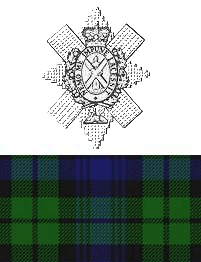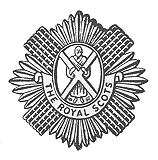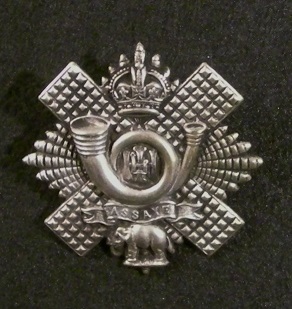
The Black Watch, 3rd Battalion, Royal Regiment of Scotland is an infantry battalion of the Royal Regiment of Scotland. The regiment was created as part of the Childers Reforms in 1881, when the 42nd Regiment of Foot was amalgamated with the 73rd (Perthshire) Regiment of Foot. It was known as The Black Watch from 1881 to 1931 and The Black Watch from 1931 to 2006. Part of the Scottish Division for administrative purposes from 1967, it was the senior Highland regiment. It has been part of the Scottish, Welsh and Irish Division for administrative purposes since 2017.

The Royal Scots, once known as the Royal Regiment of Foot, was the oldest and most senior infantry regiment of the line of the British Army, having been raised in 1633 during the reign of Charles I. The regiment existed continuously until 2006, when it amalgamated with the King's Own Scottish Borderers to become the Royal Scots Borderers, which merged with the Royal Highland Fusiliers, the Black Watch, the Highlanders and the Argyll and Sutherland Highlanders to form the Royal Regiment of Scotland.

The King's Own Scottish Borderers (KOSBs) was a line infantry regiment of the British Army, part of the Scottish Division. On 28 March 2006 the regiment was amalgamated with the Royal Scots, the Royal Highland Fusiliers, the Black Watch, the Highlanders, the Argyll and Sutherland Highlanders, 52nd Lowland Regiment, and 51st Highland Regiment to form the Royal Regiment of Scotland. However, after just a few months the battalion merged with the Royal Scots Battalion to form the Royal Scots Borderers.

The Argyll and Sutherland Highlanders (Princess Louise's) is a light infantry company (designated as Balaklava Company, 5th Battalion, Royal Regiment of Scotland) and was a line infantry regiment of the British Army that existed from 1881 until amalgamation into the Royal Regiment of Scotland on 28 March 2006.

The Royal Scots Fusiliers was a line infantry regiment of the British Army that existed from 1678 until 1959 when it was amalgamated with the Highland Light Infantry to form the Royal Highland Fusiliers which was later itself merged with the Royal Scots, King's Own Scottish Borderers, the Black Watch, the Argyll and Sutherland Highlanders and the Highlanders to form a new large regiment, the Royal Regiment of Scotland.

The Highland Light Infantry (HLI) was a light infantry regiment of the British Army formed in 1881. It took part in the First and Second World Wars, until it was amalgamated with the Royal Scots Fusiliers in 1959 to form the Royal Highland Fusiliers which later merged with the Royal Scots Borderers, the Black Watch, the Highlanders and the Argyll and Sutherland Highlanders to form the Royal Regiment of Scotland, becoming the 2nd Battalion of the new regiment.

The Gordon Highlanders was a line infantry regiment of the British Army that existed for 113 years, from 1881 until 1994, when it was amalgamated with The Queen's Own Highlanders to form The Highlanders. Although the 'Gordon Highlanders' had existed as the 92nd Regiment of Foot since 1794, the actual 'Gordon Highlanders Regiment' was formed in 1881 by amalgamation of the 75th (Stirlingshire) Regiment of Foot and 92nd Regiment of Foot.

The 51st Highland Volunteers is a battalion in the British Army's Army Reserve or reserve force in the Scottish Highlands, forming the 7th Battalion of the Royal Regiment of Scotland, also known as 7 SCOTS. It is one of two Reserve battalions in the Royal Regiment of Scotland, along with 52nd Lowland, a similar unit located in the Scottish Lowlands.

The Seaforth Highlanders was a line infantry regiment of the British Army, mainly associated with large areas of the northern Highlands of Scotland. The regiment existed from 1881 to 1961, and saw service in World War I and World War II, along with many smaller conflicts. In 1961 the regiment was amalgamated with the Queen's Own Cameron Highlanders to form the Queen's Own Highlanders, which merged, in 1994, with the Gordon Highlanders to form the Highlanders. This later joined the Royal Scots Borderers, the Black Watch, the Royal Highland Fusiliers and the Argyll and Sutherland Highlanders to create the present Royal Regiment of Scotland.

A Scottish regiment is any regiment that at some time in its history has or had a name that referred to Scotland or some part thereof, and adopted items of Scottish dress. These regiments were created after the Acts of Union in 1707 between England and Scotland, either directly serving Britain during its various wars, or as part of the military establishments of Commonwealth countries. Their "Scottishness" is no longer necessarily due to recruitment in Scotland nor any proportion of members of Scottish ancestry.

The Glasgow Highlanders was a former infantry regiment of the British Army, part of the Territorial Force, later renamed the Territorial Army. The regiment eventually became a Volunteer Battalion of the Highland Light Infantry in 1881. The regiment saw active service in both World War I and World War II. In 1959 the Highland Light Infantry was amalgamated with the Royal Scots Fusiliers to form the Royal Highland Fusiliers. The Glasgow Highlanders was later amalgamated into the 52nd Lowland Volunteers in 1967.
The 26th Infantry Brigade was the name of two British Army formations during the First World War and Second World War.

152nd Infantry Brigade was a formation of Britain's Territorial Force/Territorial Army that was part of 51st (Highland) Division in both World Wars. From its origins in the 19th Century Volunteer Force it was based in Inverness and was composed of Highland battalions. It served on the Western Front in World War I, and after it was captured at Saint-Valery-en-Caux early in World War II it was reformed from its 2nd Line and saw action in North Africa, Sicily and North West Europe.

153rd Infantry Brigade was a formation of Britain's Territorial Force/Territorial Army that was part of 51st (Highland) Division in both World Wars. From its origins in the 19th Century Volunteer Force it was based in Aberdeen and was composed of Highland battalions. It served on the Western Front in World War I, and after it was captured at Saint-Valery-en-Caux early in World War II it was reformed from its 2nd Line and saw action in North Africa, Sicily and North West Europe. It continued serving postwar until the reduction of the Territorial Army in the 1960s.

154th Infantry Brigade was a formation of Britain's Territorial Force/Territorial Army that was part of 51st (Highland) Division in both World Wars. From its origins in the 19th Century Volunteer Force it was based in Stirling and was composed of Highland battalions. It served on the Western Front in World War I, and after it escaped from France early in World War II it was reformed from its 2nd Line and saw action in North Africa, Sicily and North West Europe. It continued serving postwar until the reduction of the Territorial Army in the 1960s.
The Lowland Band of the Royal Regiment of Scotland is a military band in the Territorial Army and one of three military bands in the Royal Regiment of Scotland. The band is based at the East Claremont Street drill hall in Edinburgh and is administered by 52nd Lowland, 6th Battalion, The Royal Regiment of Scotland. The other two bands in the Regiment are the regular Regimental Band of the Royal Regiment of Scotland, which is based at Dreghorn Barracks in Edinburgh and is administered by the Royal Corps of Army Music, and the other is the territorial Highland Band of the Royal Regiment of Scotland, which is based at Queen's Barracks in Perth and administered by 51st Highland, 7th Battalion, The Royal Regiment of Scotland.
The 155th Brigade was an infantry brigade of the British Army that saw active service in both the First and the Second World Wars. Assigned to the 52nd (Lowland) Division, the brigade saw active service in the Middle East and on the Western Front during the First World War. During the Second World War, now the 155th Infantry Brigade, it continued to serve with the 52nd Division in Operation Dynamo, and later in North-western Europe from late 1944 until May 1945.
The 157th Brigade was an infantry brigade of the British Army. The brigade fought in both the First and the Second World Wars, assigned to 52nd (Lowland) Infantry Division.
221st Mixed Brigade was a Scottish Home Service formation of the British Army that served under various titles throughout World War I.

Hepburn House, also known as East Claremont Street Drill Hall, is a military installation in Edinburgh.













